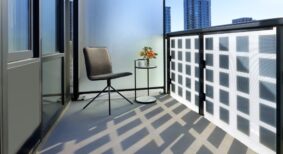Reaching net zero by 2050 means sustainability targets for all buildings, both old and new, will need to change quickly. This includes existing condo buildings.
As building performance levels increase at an accelerated rate, it’s not surprising that condos built several decades ago will start falling behind the status quo if upgrades are not made. Choosing the right building energy and sustainability revamps is critical for keeping pace with today’s green ambitions.
When it comes to energy upgrades, the best candidates are condo buildings that need some work done anyway. For example, if a building already has windows, a roof and HVAC systems all in need of replacement, then it just comes down to looking at the premium to get the best possible product while optimizing integration. That’s exactly where an energy study comes in.
The energy study can be coupled with a life cycle assessment (LCA) to assess other environmental impacts of potential building upgrades. This includes analyzing the condo’s carbon footprint, both embodied and operational.
Currently, a major focus is minimizing embodied carbon in buildings, and this is where existing condos have an advantage; the building with the lowest embodied carbon is the one that has already been built.
A vital strategy in this “time value of carbon” approach is to maintain existing buildings. This cuts out all the embodied carbon emissions that are associated with material extraction, manufacturing and construction of a brand-new building. Energy models and LCAs are vital decision-making tools, as they help owners analyze embodied carbon and greenhouse gas emissions on their projects, as well as energy use and cost.
Popular sustainability revamps
Window replacement
Improved insulation for windows trickles down to improved energy efficiency. When condo windows are replaced, less energy is needed to regulate temperatures, saving work for the HVAC system.
For older condos in the 30- to 50-year range, window replacements have a major impact on occupant comfort and energy use. As a weak point in the building envelope, windows transfer a significant amount of heat and they can leak.
Energy modelling can be leveraged to compare the benefits of high-performance windows versus standard windows. This often includes looking at energy savings to estimate the payback on the premium investment, as well as how high windows need to perform to allow for a smaller or electrified HVAC system.
Trained professionals can best assess different options for window replacements, working with a board to set clear priorities. Sometimes the right approach means replacing the windows and frame. This can be costly, but ultimately yield stronger performance. Other times, just the glass can be replaced, creating cost efficiencies and less disruption for residents.
Roofing replacement
Replacing your condo building’s roof does so much more than keeping rain and snow out; it also improves overall energy efficiency by creating better insulation. Much like for window replacements, energy modelling can be used ahead of roofing replacements to determine the return on investment garnered from higher amounts of insulation.
Overcladding or recladding
While window and roofing upgrades call for simple lifecycle replacements, cladding is often not fully replaced but rather maintained. For example, brick or precast cladding can last as long as 75 to 100 years without any full replacements needed. That being said, cladding systems are sometimes replaced or overclad in response to leaks, new goals to elevate an older condo aesthetic, or to improve energy performance.
If overcladding or recladding is already being considered for a condo complex, a deep energy retrofit may be a good fit. It is recommended to bundle the cladding upgrade with window and roofing replacements, plus an energy study to unveil whether the HVAC system can be improved or minimized in any way.
HVAC systems
The main driver behind a building’s carbon emissions will depend on its heating and hot water systems, which can be fossil-fuel fired or electric. Dubbed “fuel-switching,” changing from oil or gas to an efficient electric system can be the fastest way to reduce a building’s operational carbon emissions.
Older buildings often have what would now be considered insufficient ventilation: an issue brought into public awareness amid the COVID-19 pandemic. Energy audits are a great way to analyze the building as a whole and determine the best strategies to improve both energy efficiency and carbon reduction. While replacing HVAC systems may be critical for lowering operational carbon, upgrading the building envelope is a solid first step. This often results in a smaller, and therefore less costly, HVAC replacement.
Energy efficiency in action
Many current projects feature replacement for windows and heating/cooling systems, such as changing PTAC (packaged terminal air condition) units to more efficient split systems. This improves comfort and reduces energy usage with a minimal premium, if any, over simple end-of-life replacement costs. These upgrades are also easily completed in existing buildings while they’re occupied.
Contractors are knowledgeable and experienced in the work and coordination involved, reducing the cost and impact on the owners.
Many elements in a condo’s building envelope will last 30-plus years. A typical end-of-life replacement is often the only chance to make meaningful energy changes that will last decades. Coordinating these vital energy upgrades all together can maximize building performance. However, replacing these elements independently or without smart improvements means missing out on a once-in-a-generation opportunity to really improve building performance, reduce environmental impact, and position the building attractively in the marketplace.
This is where evaluating all options is critical. Using tools such as LCAs and hourly full building energy models allows the board to make informed decisions based on building-specific data and comprehensive options.
Jack Albert, MEng, P.Eng., LEED AP, is a Principal at RJC Engineers.
Wendy Macdonald, P.Eng., ENV SP, LEED AP BD+C, is a Sustainability Consultant at RJC Engineers.





